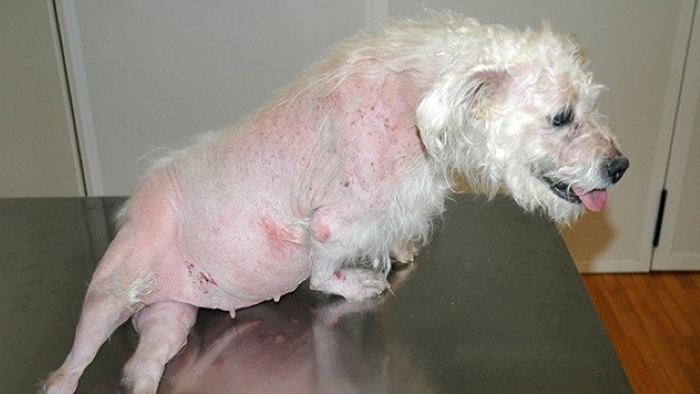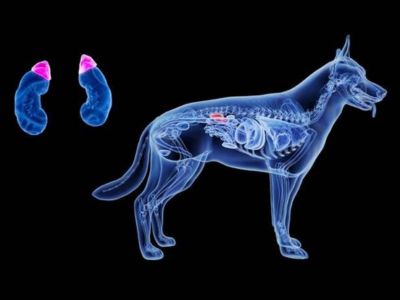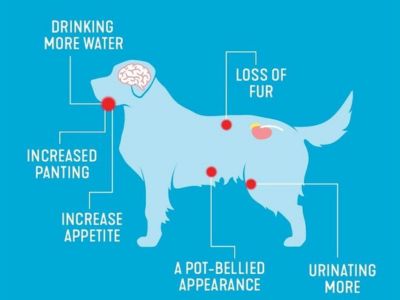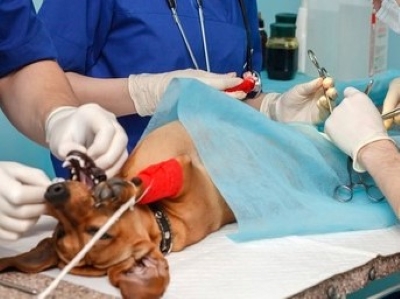Cushing’s Disease, also known as hyperadrenocorticism, is a complex medical condition that affects our beloved canine companions.

It occurs when the adrenal glands produce an excessive amount of cortisol, a hormone that plays a crucial role in the body’s response to stress.
In this blog, we’ll delve into the causes, symptoms, diagnosis, and treatment options for Cushing’s Disease in dogs, empowering dog owners with essential knowledge to ensure the well-being of their furry friends.
Contents
What is Cushing’s Disease in dogs?
The medical illness known as Hyperadrenocorticism, commonly known as Cushing’s disease in dogs, is brought on by the adrenal glands‘ excessive synthesis of the stress hormone cortisol.
Numerous reasons, such as tumors on the pituitary or adrenal glands, might contribute to this excessive cortisol production[1].

The illness causes a variety of symptoms, including weight gain, muscular weakness, skin problems, increased thirst and urination, and a potbellied look[2].
Blood tests and imaging methods are used to identify Cushing’s disease, and medication, surgery, or other medical treatments are used to control the overproduction of cortisol and treat the symptoms that go along with it.
What Causes Cushing’s Disease in Dogs?
There are three main causes of Cushing’s disease in dogs.
Pituitary-dependent Cushing’s disease
This is the most common cause, accounting for 80–85% of cases.
It occurs when a benign tumor in the pituitary gland, located at the base of the brain, produces too much of a hormone called Adrenocorticotropic Hormone (ACTH).
ACTH stimulates the adrenal glands to produce more cortisol than the body needs.
Adrenal-dependent Cushing’s disease
This accounts for 15–20% of cases. It occurs when a tumor (either benign or malignant) in one or both adrenal glands produces excess cortisol.
Iatrogenic Cushing’s disease
Prednisone and other steroids, such as those used to treat allergies, inflammation, or cancer, should not be taken long-term or in excess[3].
Steroids can inhibit the adrenal glands’ typical activity and mimic the effects of cortisol.
What Are the Symptoms of Cushing’s Disease in Dogs?
Cushing’s disease develops slowly, and the symptoms may not be noticeable at first.
Some of the common signs of Cushing’s disease in dogs are:
- Increased thirst and urination
- Increased appetite and weight gain
- Pot-bellied appearance
- Hair loss or thinning
- Recurrent skin or urinary infections
- Panting or difficulty breathing
- Lethargy or weakness
- Reduced activity or interest in play
- Sudden blindness (in some cases)
Depending on the kind and degree of Cushing’s disease as well as the particular dog, the symptoms may change.
While some dogs may only experience minor symptoms, others may experience more severe side effects, including diabetes, high blood pressure, renal failure, blood clots, or neurological issues.
How Is Cushing’s Disease in Dogs Diagnosed?
You should call your vet right away if you observe any of the aforementioned symptoms in your dog.
Your dog’s behavior and medical history will be discussed with you by your veterinarian while they examine your dog physically[4].

To examine your dog’s cortisol levels and other factors, they will also perform some blood and urine tests.
Depending on the findings, they could also do an MRI to check for tumors in the pituitary gland or an ultrasound to check for malignancies in the adrenal glands.
The diagnosis of Cushing’s disease can be challenging, as some of the symptoms and test results may overlap with other conditions.
Therefore, your veterinarian may need to perform additional tests or repeat some tests to confirm the diagnosis and determine the type and cause of Cushing’s disease.
How Is Cushing’s Disease in Dogs Treated?
The kind, etiology, general health, and age of your dog all play a role in how Cushing’s disease in dogs is treated.
Reducing excessive cortisol production, managing the symptoms, and enhancing your dog’s quality of life are the major objectives of treatment.
There are different options for treating Cushing’s disease in dogs:
Medication
This is the most typical treatment for Cushing’s disease, whether it is pituitary– or adrenal–dependent.
Numerous medications are available that either prevent cortisol from being produced or stop it from having its negative effects.
Your veterinarian has to evaluate and change the dosage of these medications on a regular basis since they may have unwanted effects or interact with other medications.
These medicines include trilostane, mitotane, ketoconazole, selegiline, and osilodrostat, to name a few.
Surgery
This is a treatment option for Cushing’s disease, an adrenal–dependent condition brought on by a benign tumor in one adrenal gland.
The damaged adrenal gland is removed after surgery (adrenalectomy), leaving the other one unaffected.

If there are no other tumors or sources of extra cortisol in the body, this can cure Cushing’s disease.
However, due to the need for general anesthesia, specific tools, and knowledge, surgery can be hazardous and challenging.
Additionally, there is a chance of bleeding, infection, or harm to additional organs during or following the operation.
Radiation therapy
This is an option for pituitary-dependent Cushing’s disease caused by a large or invasive tumor in the pituitary gland that causes neurological signs (such as seizures or blindness).
Radiation therapy involves using high–energy rays to shrink or destroy the tumor and reduce the production of ACTH.
This can improve the symptoms and quality of life of your dog, but it may not cure Cushing’s disease completely.
Radiation therapy can also have side effects such as hair loss, skin irritation, or nausea.
Steroid withdrawal
This is an option for iatrogenic Cushing’s disease caused by the use of steroids for other conditions.
The treatment involves gradually reducing and stopping the use of steroids under the guidance of your veterinarian.
This can allow the adrenal glands to resume their normal function and restore the balance of cortisol in the body.
However, this process can take several weeks or months, and your dog may experience withdrawal symptoms such as weakness, vomiting, or low blood pressure.
How to Care for a Dog with Cushing’s Disease
Caring for a dog with Cushing’s disease can be challenging, but there are some things you can do to help your dog live a comfortable and happy life.
Some of the tips are:
- Follow your veterinarian’s instructions and recommendations regarding the treatment plan, medication dosage, monitoring schedule, and follow–up visits.

- Provide fresh water and a balanced meal that fits your dog’s nutritional needs while preventing obesity.
- Give your dog no snacks or human meals heavy in fat, sugar, or salt.
- Maintain a tidy and welcoming environment for your dog.
- A comfy mattress, enough shade, and ventilation should be provided.
- Take care not to subject them to high or low stress levels.
- A comfy mattress, enough shade, and ventilation should be provided.
- Maintain the hygiene and grooming of your dog.
- Brush their coats on a regular basis, clean their ears and eyes, and keep their nails trimmed.
- Examine their skin for indications of infection or irritation, and treat them as soon as possible.
- Brush their coats on a regular basis, clean their ears and eyes, and keep their nails trimmed.
- Keep an eye on the signs and actions of your dog.
- Inform your veterinarian as soon as you notice any modifications or problems.
- If your dog displays symptoms of severe pain, bleeding, breathing problems, or collapse, get medical help.
- Inform your veterinarian as soon as you notice any modifications or problems.
FAQs
Can Cushing’s Disease be cured?
Cushing’s Disease can be managed but may not always be completely cured. Treatment options include medication to regulate cortisol levels, surgical removal of adrenal tumors, and lifestyle adjustments.
Can dogs with Cushing’s Disease lead normal lives?
With proper treatment and management, dogs with Cushing’s Disease can lead comfortable lives. Regular veterinary check-ups, medication administration, and a balanced lifestyle can help maintain their well-being.
Is Cushing’s Disease preventable?
Cushing’s Disease is not always preventable, especially in cases caused by underlying medical conditions. However, avoiding unnecessary use of corticosteroid medications and providing a healthy lifestyle can reduce the risk of iatrogenic Cushing’s Disease.
Are certain dog breeds more susceptible to Cushing’s Disease?
While Cushing’s Disease can affect dogs of any breed, certain breeds, such as Poodles, Dachshunds, and Boston Terriers, seem to have a higher predisposition to the condition.
Can Cushing’s Disease be fatal?
If left untreated, Cushing’s Disease can lead to serious complications affecting various organ systems. However, with appropriate veterinary care and management, many dogs with Cushing’s Disease can have a good prognosis and quality of life.
Conclusion
Cushing’s Disease in dogs is a challenging condition, but with proper veterinary care and a well-informed approach, it can be managed effectively.
Early detection and treatment play a vital role in ensuring your furry friend’s comfort and health.
If you suspect your dog might be exhibiting symptoms of Cushing’s Disease, don’t hesitate to reach out to your veterinarian for guidance and support.
Your furry companion deserves a happy, healthy life, and your vigilance can make all the difference.
Reference:
- Adrenal gland tumors in dogs | PetMD
- Skin problems in dogs | WebMD
- Cancer in pets | American Veterinary Medical Association
- Common Dog Behaviors & the Meaning | Hill’s Pet Nutrition

Dania is a dog groomer living in California, who loves styling dogs. She often uses dog accessories to keep them distracted while grooming. She is also a dog parent to a Pomeranian, Duke. It’s because of him she is always on a lookout for the best dog foods, toys, other dog accessories, and ways to keep him equipped, healthy and happy.


